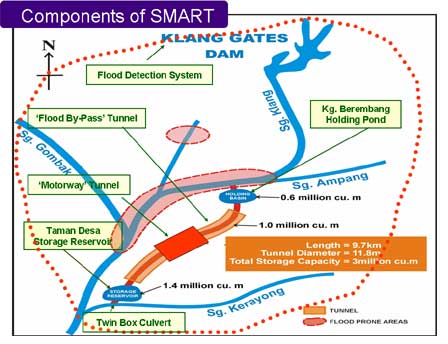
Published by Malay Mail & The Malaysian Reserve, image by Department of Irrigation and Drainage. (Ministry of Water, Land and Natural Resources)
Flash floods are a common experience in urban areas across the country. However, unlike coastal flooding, duration of rainfall in the West Coast of Peninsular Malaysia is not prolonged as in the East Coast. And the rate of flood water subsiding is faster in the West Coast too.
Nevertheless, urbanites have become accustomed to the point of being virtually “fatalistic”. It seems that apart from acquiring bricks and piling these beneath furniture or positioning sandbags at the entrance to the house, we can only pray and hope that the level of the flood water is benign and no more than ankle deep, if at all.
The time has come for us to implement a more integrated and sustainable method and practice of flood management in the urban areas — combining the current system and practice of dispersion with that of the newer method of absorption.
Following countries such as China and Germany, the concept of urban “water sponges” should be assimilated into all urban development, re-development, design and planning in the country as part of the national flood management strategy.
We already have SMART (Stormwater Management and Road Tunnel) that covers Masjid Jamek, Leboh Ampang, Jalan Melaka, Dataran Merdeka, Dang Wangi, Leboh pasar, Pasar Seni & Daya Bumi.
The tunnel itself is approximately 9.7 km long with a 4km dual-deck motorway within it. The entrances (ingress)/exits (egress) connections are located at Sg Besi near Bandar Malaysia, Jalan Tun Razak near the Tun Razak Exchange (TRX) and Jalan Sultan Ismail, at the intersection between Park Royal Hotel and Berjaya Time Square.
SMART is “interconnected” with a series of rivers and tributaries (directly and indirectly in terms of the expected direction and flow of the flood water and surface runoff) by being strategically situated along in “perpendicular” fashion and intersecting and bisecting with the Sg Klang and Sg Ampang confluence on one side, and Sg Klang and Sg Gombak confluence on the other side of the tunnel.
Total storage capacity is at 3 million cubic per metre (m3) at its maximum/optimum (roughly equivalent to at least 1,200 Olympic-sized swimming pools), although in practice SMART has accommodated 3.5 m3 before in July 2018.
The fundamental strategy of SMART can be conceptualised to constrain the flow of stormwater from upstream to downstream Kuala Lumpur on the basis of “divert, store and release”.
Excess flood water at the upstream of the Sg Klang and Sg Ampang confluence would be diverted via a diversion weir that controls the level and subsequently stored in the 8 hectares Kampung Berembang holding basin or retention pond.
Through the SMART waterway tunnel, stormwater pass to the Taman Desa attenuation pond downstream only to be released into Sg Kerayong. The automated flood gates operate in tandem (but in reverse) with the road gates using a hydraulic system so as to be water resistant.
When SMART is in Mode 3 or 4, then the flood gates are opened and the road gates at both ends of the “junction boxes” of the motorway feature of SMART would be sealed, and vice versa when the situation has been normalised.
SMART has been dubbed as one of the top ten structural wonders of the world by CNN. And not only as a major engineering feat but earning the accolade as being the first of its kind — in serving as a dual-purpose tunnel.
The concept of SMART should therefore be replicated both within and outside of the Greater Kuala Lumpur Area, whether on a similar scale or down-sized.
The concept should merge and “synthesised” with the concept of urban sponge as mentioned in the introduction to this article — both by replicating nature and using concrete.
Replicating nature entails the construction of semi-artificial or blended water catchment areas or basins. But how do we do that?
Nature:
- For one, constructing waterways and canals in the newer developments would serve a triple purpose of flood management, aesthetics and water security.
- The creation of artificial hills or mounds should also be explored in that there would be layers of grass, plants and trees. “Delineating” their base is a system of drainage interspersed by twin culverts. The drainage could be connected to the rivers (for the purpose of discharge) and underground tunnels (for the purpose of detention and storage).
- Rain gardens (bioretention facilities) should also be promoted as they can play the role of a detention/ retention pond or basin on a much smaller scale.
- Artificial lakes should be an integral aspect of urban planning and design as well as a developer’s masterplan.
- Rivers should continue to be rehabilitated and dredged. Also, the construction of strategically located pump stations and diversion weirs to complement and supplement the discharge of flood waters.
Concrete:
- Drainage system be upgraded to include second tier drain channel that will be opened by automated sensors when the water pressure calculated according to rheological (flow of liquid) properties of stress and strain.
- Otherwise, the entire stretch of the roads could be converted into an artificial alluvial basin. Their bitumen cum asphalt plus tar must be replaced with permeable and porous concrete. Design include “single-sized aggregate” comprising loose gravel or stone chipping; plastic grids that can also be planted with grass just like the permeable pavements in Malaysia pioneered in Bandar Sunway via the use of NeuPave manufactured by Sunway Paving Solutions, a wholly-owned subsidiary of Sunway Berhad.
- The construction of (giant) underground water storage tanks and facilities (following the example of Japan’s Metropolitan Area Outer Underground Discharge Channel in Kasukabe, Saitama — north of Tokyo) — which protects from vaporisation and provide insulation from heat and therefore allowing for longer or ‘perpetual’ life span. Ideally, the underground water supply should be stored in and near flood prone areas where e.g., a storm tunnel can also be installed — to divert surface run-offs.
- The creation of basins, detention and retention ponds that are linked to the underground water tanks in the industrial and commercial zones whereby some are under the respective state entity or state government-linked company whilst others would be under private ownership.
- Ensuring that all buildings have sky gardens as part of the Green Building Index (GBI) certification.
Not least the Internet of Things (IoT) such as ultrasonic, temperature and humidity sensors and drones alongside artificial intelligence (AI) such as robotic process automation that will play a critical role in the monitoring and surveillance as well as early warning system vis-à-vis water level detection.
Flood management is a key and critical policy issue requiring priority policy attention since it impacts on the quality of life, access to front-line services, and indirectly on the cost of living.
Our government should therefore continue to step up efforts to upgrade our flood defences as part of the nation’s human security as well as combating and mitigating the effects of climate change.
Jason Loh Seong Wei is Head of Social, Law and Human Rights at EMIR Research, an independent think tank focused on strategic policy recommendations based on rigorous research.

